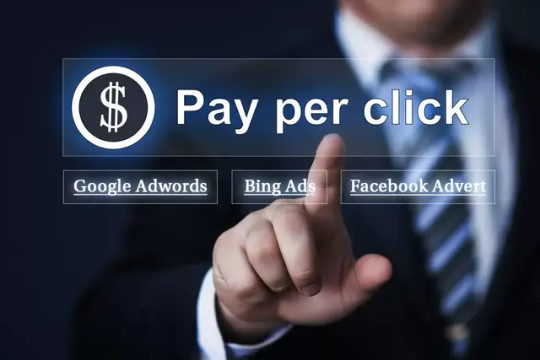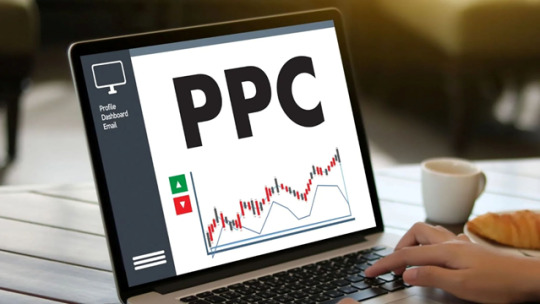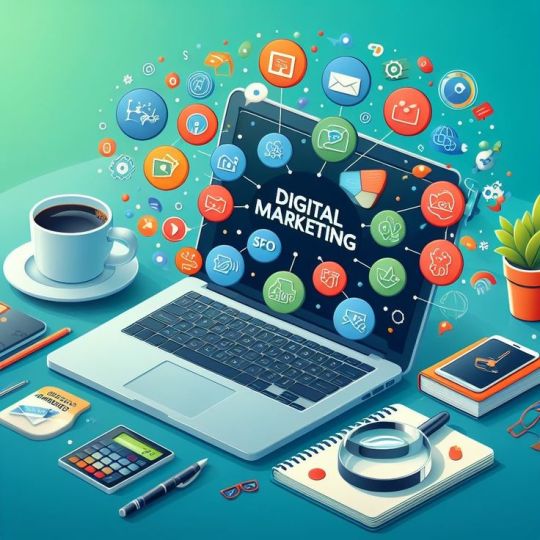#What is PPC advertising?
Explore tagged Tumblr posts
Text
What is PPC advertising?

In the world of digital marketing, PPC advertising has emerged as a powerful tool for businesses to drive traffic, generate leads, and increase sales with measurable results. Whether you're a small local business or a global brand, PPC offers a way to reach your audience exactly when they're searching for your products or services.
This article will explain what PPC advertising is, how it works, its major components, benefits, and how to get started.
Definition of PPC Advertising
PPC (Pay-Per-Click) advertising is an online marketing model in which advertisers pay a fee each time their ad is clicked. Instead of earning organic visits through search engine optimization (SEO), PPC allows businesses to buy visits to their websites via targeted ads.
The most well-known PPC platform is Google Ads, but other platforms like Bing Ads, Facebook Ads, Instagram Ads, and LinkedIn Ads also use the same model.
How Does PPC Advertising Work?
PPC advertising functions through a bidding system and keyword targeting. Here’s how the process works:
1. Keyword Selection
Advertisers choose keywords that their target audience is likely to search for. For example, a bakery may use keywords like “order birthday cake online” or “best chocolate cake near me.”
2. Bidding in the Auction
Each advertiser sets a maximum bid for how much they’re willing to pay per click on a particular keyword.
3. Ad Placement
When a user enters a search query, the platform runs an auction based on:
Keyword relevance
Bid amount
Ad quality (measured by CTR, relevance, landing page experience)
The ads that win the auction are shown to the user.
4. Cost per Click
You only pay when someone actually clicks on your ad—not when it’s viewed.
Key Components of a PPC Campaign
A well-structured PPC campaign consists of several critical elements:
Keywords
Selecting high-intent, relevant keywords is the foundation of PPC. Use keyword research tools like Google Keyword Planner or SEMrush.
Ad Copy
Your ad must be compelling, clear, and offer value—usually with a strong call-to-action (e.g., “Sign Up Free,” “Call Now”).
Landing Page
The user’s destination after clicking the ad. A good landing page matches the ad’s promise and encourages conversions.
Ad Extensions
These are additional links or info (e.g., phone numbers, ratings, location) that enhance your ad’s appearance and clickability.
Benefits of PPC Advertising
PPC offers many advantages that make it attractive to marketers and business owners:
Immediate Results
Unlike SEO, which takes time, PPC campaigns can start delivering traffic the same day they go live.
Highly Targeted
You can target by keywords, location, device type, demographics, time, and even interests or behaviors.
Budget Control
Set daily or campaign-level budgets and adjust them anytime. You’re only charged for actual clicks.
Performance Tracking
Every metric—from impressions to conversions—is measurable. This allows for optimization and better ROI.
Brand Visibility
Even if people don’t click, your ad appears on top of search results—boosting brand awareness.
Where is PPC Used?
PPC can be implemented across multiple digital platforms, including:
Search Engines: Google Ads, Bing Ads
Social Media: Facebook, Instagram, LinkedIn, Twitter
E-commerce Platforms: Amazon PPC, Etsy Ads
Display Networks: Banner and visual ads on partner websites
Each platform offers unique targeting features and audience reach, depending on your business goals.
How to Get Started with PPC?
Here’s a beginner’s roadmap to launching your first PPC campaign:
Choose a Platform – Google Ads is a popular starting point.
Do Keyword Research – Use keyword tools to find terms your audience uses.
Write Ad Copy – Make it clear, relevant, and action-oriented.
Create a Landing Page – Align it with your ad message.
Set a Budget – Start small and scale once you see results.
Monitor Performance – Use analytics tools to refine your strategy.
Is PPC Right for Every Business?
PPC can benefit most businesses, but its effectiveness depends on:
Your industry and competition
The lifetime value of your customer
Your ad spend budget
How well you optimize your campaigns
If your goal is quick traffic, lead generation, or brand exposure, PPC is a smart investment. However, it should ideally be combined with long-term strategies like SEO and content marketing.
Conclusion
PPC advertising course is a dynamic, scalable, and results-driven strategy that can give businesses a competitive edge in the online marketplace. By understanding how it works and implementing it with best practices, you can effectively drive targeted traffic, maximize ROI, and grow your business presence online.
Whether you're a beginner or a growing brand, PPC offers a level of control, precision, and measurability that few other marketing channels can match.
0 notes
Text
#ppc#ppc marketing#ppc services#ppcadvertising#How to Maximize PPC Performance#What is PPC Advertising?#How to Optimize PPC Campaigns#Tips to Maximize PPC Performance#Magnarevo
0 notes
Text
what are the benefits of ppc advertising for small businesses?
PPC advertising offers small businesses a cost-effective way to quickly reach targeted audiences. It provides instant visibility on search engines and social platforms, helping businesses attract potential customers immediately. One major advantage is that you only pay when someone clicks on your ad, making it budget-friendly and measurable. PPC also allows precise targeting based on location, keywords, interests, and demographics. Additionally, campaigns can be easily adjusted or paused in real-time. What are the benefits of PPC advertising for small businesses? It helps drive traffic, boost brand awareness, and compete effectively with larger companies.
0 notes
Text
Title: Why Pay-Per-Click Advertising Is Essential for E-commerce Success Description: For e-commerce businesses, PPC advertising is an essential strategy for driving targeted traffic and increasing conversions. Learn how to set up PPC campaigns that specifically cater to your products, optimize your ad copy, and manage bids effectively. By the end of this guide, you'll have the tools and knowledge to create successful PPC ads that drive sales and maximize ROI. Whether you're a small business or a large e-commerce site, PPC can help you achieve your marketing goals and grow your online presence.
0 notes
Text
What is PPC Advertising? Unlock the Secret to Scaling Your E-Commerce Brand
In the fast-paced world of e-commerce, businesses need to adopt cutting-edge strategies to stay competitive. One of the most effective ways to attract immediate traffic and generate high-quality leads is through PPC (Pay-Per-Click) advertising. But what exactly is PPC advertising, and how can it transform your e-commerce brand?
This blog unpacks the essentials of PPC advertising, its significance for e-commerce, key strategies for success, and the role a PPC advertising agency can play in boosting your digital marketing efforts.
What is PPC Advertising?
PPC advertising is a digital marketing model where advertisers pay a fee each time someone clicks on their ad. These ads typically appear on platforms like Google, social media, and websites, targeting users actively searching for specific products or services.

The most widely used platform for PPC is Google Ads, where businesses bid on keywords to display their ads in search engine results. For e-commerce brands, PPC advertising is a game-changer, offering immediate visibility and driving qualified traffic to their stores.
Why is PPC Advertising Crucial for E-Commerce Brands?
Here’s why PPC advertising is indispensable for scaling e-commerce businesses:
Instant Traffic Boost Unlike SEO, which takes time to deliver results, PPC advertising provides immediate visibility. Whether you’re launching a new product, running a seasonal sale, or promoting a limited-time offer, PPC campaigns can drive instant traffic to your site.
Highly Targeted Campaigns PPC enables precise targeting based on keywords, demographics, location, and even browsing behavior. This ensures your ads reach the right audience at the right time, significantly improving conversion rates.
Cost Efficiency and Flexibility With PPC, you only pay for actual clicks, giving you complete control over your advertising budget. You can set daily or monthly spending limits to ensure cost efficiency.
Data-Driven Insights PPC platforms provide comprehensive analytics to track key metrics like click-through rates (CTR), cost-per-click (CPC), and return on investment (ROI). This helps refine strategies and improve campaign performance.
How to Build a Successful PPC Campaign
A well-structured PPC campaign can unlock immense potential for your e-commerce store. Here are some essential steps:
Conduct Thorough Keyword Research Identify the keywords your target audience uses to find products like yours. Utilize tools like Google Keyword Planner to select high-performing keywords, including a mix of broad and long-tail options.
Craft Engaging Ad Copy Your ad copy should capture attention and compel users to click. Highlight your unique selling points, include actionable CTAs like “Shop Now,” and ensure your landing pages are optimized for seamless conversions.
Leverage Negative Keywords Exclude irrelevant keywords to avoid wasting ad spend. For instance, if you sell luxury watches, you might exclude keywords like “cheap” or “budget” to attract the right audience.
Track Conversions Set up conversion tracking to measure how many clicks result in sales, sign-ups, or other desired actions. This data is invaluable for optimizing campaigns.
Test and Optimize Regularly Continuously test different ad elements, including copy, keywords, and landing pages, to identify what performs best. Use A/B testing to refine your campaigns and maximize ROI.
Advanced PPC Strategies for Scaling E-Commerce
To take your PPC campaigns to the next level, consider implementing these advanced strategies:
Retargeting Ads Re-engage users who visited your site but didn’t convert. Retargeting ads remind them of the products they viewed, encouraging them to complete their purchase.
Google Shopping Ads Showcase product details directly in search results with Google Shopping Ads. These ads provide images, prices, and store information, making it easier for users to make purchasing decisions.
Mobile Optimization With mobile shopping on the rise, ensure your ads and landing pages are mobile-friendly. A seamless mobile experience can significantly boost conversions.
Ad Extensions Enhance your ads with additional features like site links, contact details, or location information. Ad extensions make your ads more informative and engaging.
Dynamic Keyword Insertion (DKI) DKI customizes your ad copy based on the user’s search query, increasing relevance and click potential. Use it strategically to avoid generic messaging.
The Value of Partnering with a PPC Advertising Agency
Managing PPC campaigns in-house can be time-consuming and complex. This is where a professional PPC advertising agency can make a difference.
Expert Knowledge PPC agencies specialize in crafting effective campaigns, offering expertise that ensures your ads perform optimally.
Time-Saving Outsourcing to a PPC advertising agency allows you to focus on running your e-commerce store while experts handle your campaigns.
Access to Advanced Tools Agencies leverage advanced tools for keyword research, performance tracking, and bid management, ensuring efficient campaign optimization.
Scalability Whether you’re expanding to new markets or launching new products, a PPC advertising agency can scale your campaigns to meet your growth goals.
Final Thoughts
PPC advertising is a powerful strategy for driving targeted traffic, increasing conversions, and scaling e-commerce brands. By leveraging advanced PPC strategies and working with a trusted PPC advertising agency, you can maximize your ad spend and achieve sustainable growth.
At Good On Digital, we specialize in creating data-driven PPC campaigns tailored to e-commerce businesses. Let us help you unlock the full potential of PPC advertising and elevate your brand.
📩 Ready to grow your e-commerce store? Book a free consultation with us today!
Follow us on Instagram for expert insights and updates!
#PPCAdvertising#EcommerceGrowth#what is ppc advertising#ppc advertising strategies#ppc advertising agency#ppc marketing agency#pay per click marketing#best pay per click agencies#ppc ads specialist#Pay per click advertising
0 notes
Text

#Full Stack Digital Marketing Agency#Search Engine Optimization PPC Advertising#Social Media Marketing#Website Design & Development#Content Marketing#The Future of Digital Marketing#what is the future of digital marketing#The scope of digital marketing in future#Future of Digital Marketing in India#Recent Google Searches#AdWords#Artificial intelligence (AI)
0 notes
Text
Comprehensive Guide to Mastering Pay-Per-Click (PPC) Advertising

In the competitive landscape of digital marketing, Pay-Per-Click (PPC) advertising stands as a critical tool for businesses aiming to enhance their online presence, drive targeted traffic, and achieve measurable results. This guide delves deeply into the mechanics of PPC, explaining What is 'PPC' in digital marketing, its myriad benefits, essential strategies, and best practices to maximize its potential, ensuring your campaigns outperform competitors and deliver exceptional returns.
#what is ppc in digital marketing#ppc definition in marketing#pay-per-click advertising explained#benefits of ppc marketing#how ppc works in digital advertising#ppc strategies for digital marketers#examples of ppc campaigns#ppc vs seo comparison#ppc marketing tools#ppc advertising tips for beginners
0 notes
Text
Amal p k Your Gateway to Top Freelance Digital Marketing Services in Kerala

Introduction In today’s digital-first world, having a strong online presence is no longer optional—it’s essential. For businesses in Kerala looking to thrive in the competitive digital landscape, Best freelance digital marketer in kerala | calicut | kochi stands out as a trusted partner. Specializing in freelance digital marketing and SEO services, Best freelance digital marketer in kerala | calicut | kochi is helping businesses unlock their full potential online. In this blog, we’ll dive into what makes Best freelance digital marketer in kerala | calicut | kochi the go-to choice for businesses seeking the best freelance digital marketer in Kerala.
Why Choose Best freelance digital marketer in kerala | calicut | kochi?
Expertise in Freelance Digital Marketing Best freelance digital marketer in kerala | calicut | kochi is home to some of the top digital marketers in Kerala, offering a wide range of services, including SEO, social media marketing, content marketing, and more. Their team of skilled freelancers ensures that your business gets the attention it deserves.
Tailored SEO Strategies As a leading SEO specialist in Kerala, Best freelance digital marketer in kerala | calicut | kochi focuses on creating customized SEO strategies that drive organic traffic and improve search engine rankings. Whether it’s on-page optimization, keyword research, or technical SEO, they’ve got you covered.
Cost-Effective Solutions Hiring a full-time digital marketing team can be expensive. Best freelance digital marketer in kerala | calicut | kochi offers affordable, high-quality freelance digital marketing services, making it the perfect choice for startups and small businesses.
Proven Track Record With a portfolio of successful campaigns and satisfied clients, Best freelance digital marketer in kerala | calicut | kochi has established itself as one of the best digital marketers in Kerala. Their results-driven approach ensures that your business achieves its online goals.
Services Offered by Best freelance digital marketer in kerala | calicut | kochi Amaldigiworld.in provides a comprehensive suite of digital marketing services, including:
Search Engine Optimization (SEO): Boost your website’s visibility on search engines.
Social Media Marketing: Engage your audience on platforms like Facebook, Instagram, and LinkedIn.
Content Marketing: Create compelling content that resonates with your target audience.
Pay-Per-Click (PPC) Advertising: Drive instant traffic with targeted ads.
Website Design and Development: Build a user-friendly, responsive website that converts.
Analytics and Reporting: Track your performance and make data-driven decisions.
What Sets Best freelance digital marketer in kerala | calicut | kochi Apart?
Local Market Understanding Being based in Kerala, Best freelance digital marketer in kerala | calicut | kochi has a deep understanding of the local market. This allows them to create strategies that resonate with the target audience in Kerala.
Client-Centric Approach At Best freelance digital marketer in kerala | calicut | kochi, the client always comes first. They take the time to understand your business goals and tailor their services to meet your unique needs.
Transparency and Communication Clear communication and transparency are at the core of Best freelance digital marketer in kerala | calicut | kochi’s values. They keep you informed at every step of the process, ensuring a seamless collaboration.
Focus on Results Best freelance digital marketer in kerala | calicut | kochi doesn’t just promise results—they deliver. Their data-driven strategies are designed to maximize ROI and help your business grow.
Success Stories: How Best freelance digital marketer in kerala | calicut | kochi is Transforming Businesses Amaldigiworld.in has helped numerous businesses in Kerala achieve their digital marketing goals. From increasing website traffic to improving search engine rankings, their success stories speak for themselves. Here are a few examples:
A local e-commerce store saw a 300% increase in organic traffic within six months of partnering with Best freelance digital marketer in kerala | calicut | kochi.
A Kerala-based restaurant chain experienced a 50% boost in online reservations after implementing their social media marketing strategies.
A startup in Kochi achieved top rankings for competitive keywords thanks to Best freelance digital marketer in kerala | calicut | kochi’s SEO expertise.
How to Get Started with Best freelance digital marketer in kerala | calicut | kochi Ready to take your business to the next level? Here’s how you can get started with Amaldigiworld.in:
Visit Their Website: Head over to Amaldigiworld.in to learn more about their services.
Schedule a Consultation: Book a free consultation to discuss your business goals and requirements.
Get a Customized Plan: Receive a tailored digital marketing plan designed to achieve your objectives.
Watch Your Business Grow: Sit back and watch as Best freelance digital marketer in kerala | calicut | kochi helps you achieve measurable results.
Conclusion In the ever-evolving world of digital marketing, having the right partner can make all the difference. Best freelance digital marketer in kerala | calicut | kochi has proven itself as one of the best freelance digital marketers in Kerala, offering expert SEO services, innovative strategies, and a client-centric approach. Whether you’re a startup, small business, or established brand, Amaldigiworld.in has the tools and expertise to help you succeed online.
Don’t let your competitors steal the spotlight—partner with Best freelance digital marketer in kerala | calicut | kochi today and take your digital presence to new heights!
Visit Amaldigiworld.in now to explore their services and schedule a free consultation. Have questions or thoughts? Drop them in the comments below—we’d love to hear from you!
#freelance digital marketer in kerala#seo specialist#digital marketing freelancer#top digital marketer#best digital marketer in kerala#best freelance digital marketer in kerala
16 notes
·
View notes
Text
Digital Marketing

The use of digital devices and online platforms for selling goods, services, or brands is known as digital marketing. It covers tactics such as:
-: Digital Marketing Types :- (a) Search Engine Optimization (SEO) :- Increasing a website's Google rating is known as search engine optimization, or SEO. (b) Content Marketing :- Generating videos, blogs, and infographics to draw in clients is known as content marketing. (c) Social Media Marketing (SMM) :- Using social media sites such Facebook, LinkedIn, and Instagram for your business is known as social media marketing (SMM). (d) Email Marketing :- It is the practice of connecting clients with personalized emails. (e) Pay-Per-Click (PPC) :- It is done on sites like Facebook, Google, and others. (f) Affiliate Marketing :- It is the practice of promoting other products in exchange for commissions.
(g) Influencer Marketing :- Collaborating with influencers to connect with target audiences is known as influencer marketing. (h) Mobile Marketing :- Using messages, apps, and responsive websites to target customers is known as mobile marketing.

-: What Makes Digital Marketing Vital? ~Reaching a worldwide audience. ~Being more affordable than traditional marketing. ~Offering real-time analytics and tracking. ~Having highly targeted advertising all contribute to increased engagement and brand exposure.

9 notes
·
View notes
Text
You know what Solaris needs? An arena that features a miniature city, that is to say, miniature relative to battlemechs. Where radio control cars are roughly to scale. With the battle between the battlemechs being this furious battle between these rival metal behemoths.
It would be spectacle fights. The logistical needs of rebuilding a city, even a model one, is significant. But with the right camera angles. What a terrific broadcast it would be! Ideal for mechwarriors with a lot of pageantry and showmanship. PPC blasts blowing up powerlines. Lasers cutting through a skyscraper. It would be an amazing watch. It would be a kaiju movie, mech combat and gladiatorial fights all baked into one!
And the cityscape is just free advertisement space too! If anyone one besides the solaris 7 broadcasting or whatever it is that makes decisions cares.
15 notes
·
View notes
Text

What are the advantages of digital marketing? Digital marketing offers numerous advantages over traditional marketing methods. Some of the key benefits include: 1. Cost-Effectiveness: Digital marketing is often more affordable than traditional marketing channels like TV, radio, and print. Campaigns can be tailored to fit any budget, allowing small businesses to compete with larger companies. 2. Measurability: Digital marketing provides detailed analytics and reporting, enabling marketers to track the performance of their campaigns in real time. Metrics such as click-through rates, conversion rates, and return on investment (ROI) are easily measurable. 3. Targeted Reach: Digital marketing allows precise targeting based on demographics, interests, behavior, and location. Platforms like Google Ads and Facebook Ads enable marketers to reach specific audiences that are more likely to be interested in their products or services. 4. Flexibility and Agility: Digital marketing campaigns can be quickly adjusted based on performance data. Marketers can experiment with different strategies and tactics without significant delays or costs. 5. Global Reach: The Internet provides access to a global audience, enabling businesses to expand their market beyond local or regional boundaries. E-commerce platforms and international shipping options further support global expansion. 6. Enhanced Engagement: Digital marketing channels, such as social media, email, and content marketing, facilitate direct interaction with customers. Two-way communication allows for better customer relationships and improved customer satisfaction. 7. Personalization: Digital marketing tools allow for personalized marketing messages based on user behavior and preferences. Personalization can significantly improve the customer experience and increase conversion rates. 8. Higher Conversion Rates: Digital marketing strategies like search engine optimization (SEO), pay-per-click (PPC) advertising, and social media marketing can drive highly targeted traffic to websites. This targeted traffic is more likely to convert into leads or sales. 9. Better Customer Experience: Digital marketing enables businesses to provide a seamless and integrated customer experience across various online channels. Techniques such as remarketing and automated email responses can enhance the overall customer journey. hashtag#Overall, digital marketing offers a versatile, efficient, and effective way for businesses to reach and engage with their target audience, leading to increased brand awareness, customer loyalty, and revenue growth.
15 notes
·
View notes
Text
How to Choose the Right Internet Marketing Company for Your Brand
Introduction
Navigating the digital landscape can be a daunting task, especially when it comes to selecting an effective internet marketing company. With so many options available, how do you know which marketing agency is right for your brand? This article will guide you through the intricate process of selecting the ideal partner for your online marketing efforts. We’ll explore essential factors, ask critical questions, and provide insights that will help you make an informed decision.

How to Choose the Right Internet Marketing Company for Your Brand
Choosing the right internet marketing company involves understanding both your needs and the capabilities of potential partners. Start by evaluating what services you require—be it local SEO services, social media management, or content marketing.

Why Is It Important to Choose the Right Company?
Your choice can make or break your online presence. A reputable SEO agency can elevate your brand visibility and drive traffic to your site, while a subpar one could waste marketing agencies near me your budget without delivering results.
youtube

Assessing Your Needs
Before diving into research, take a moment to clarify what you're looking for:
What are your marketing goals? Are you focusing on lead generation, brand awareness, or customer retention? What is your budget?
This self-assessment will streamline your search significantly.
Researching Potential Partners
Once you've identified your needs, start gathering options:
Online Reviews: Platforms like Google My Business and Yelp offer insights into client experiences. Case Studies: Look for agencies that showcase their successes through detailed case studies. Social Proof: Check their social media profiles. Engagement levels can indicate effectiveness. Evaluating Expertise
When researching different agencies, consider their expertise in specific areas:
Do they specialize in particular industries? Are they familiar with local market dynamics if you're targeting a specific geographic area?
An experienced marketing firm should have a proven track record in delivering successful campaigns tailored to various niches.
youtube
Key Services Offered by Internet Marketing Companies Understanding Digital Marketing Services
Digital marketing is vast and includes various services that can help boost your online presence. Here are some key offerings you might encounter:
Search Engine Optimization (SEO)
An effective SEO company utilizes strategies that enhance organic search rankings on platforms like Google. This involves keyword optimization, link-building techniques, and content creation tailored to attract target audiences.
Pay-Per-Click Advertising (PPC)
PPC campaigns can yield immediate results by placing ads at the top of search engine results pages (SERPs). Ensure any agency you're considering has experience managing PPC campaigns effectively.
Social Media Marketing
A robust social media strategy helps engage audiences where they spend much of their time online. Look for firms that of
youtube
2 notes
·
View notes
Text
What is Digital marketing
Digital marketing is the practice of promoting products or services using digital channels, technologies, and platforms, primarily on the internet. It helps businesses reach their target audience more effectively and track performance in real-time.---📱 Key Components of Digital Marketing:1. Search Engine Optimization (SEO):Improving a website's visibility on search engines like Google through keyword research, content creation, and technical enhancements.2. Social Media Marketing (SMM):Promoting brands through platforms like Instagram, Facebook, YouTube, LinkedIn, and X (Twitter).3. Content Marketing:Creating and sharing valuable content (blogs, videos, infographics) to attract and engage customers.4. Email Marketing:Sending targeted emails to nurture leads and build customer relationships.5. Pay-Per-Click Advertising (PPC):Running paid ads on platforms like Google Ads or Facebook Ads. You pay only when someone clicks
#digital marketing services#digital marketing course#digital marketing agency#online marketing#seo services#emailmarketing
2 notes
·
View notes
Text
Wheatels.com - Best digital marketing Company
Wheatels.com stands out as one of the best digital marketing companies, offering top-tier services tailored for businesses looking to elevate their online presence.
Specializing in website development, Wheatels creates user-friendly, visually appealing, and high-performing websites that serve as the foundation of any successful digital strategy.
Beyond web development, Wheatels provides comprehensive digital marketing solutions including:
SEO (Search Engine Optimization)
Social Media Marketing
PPC Advertising
Content Marketing
What sets Wheatels apart is its ability to craft customized strategies aligned with each client's unique goals, ensuring maximum ROI.
With a client-centric approach, Wheatels is committed to helping businesses not only reach but exceed their digital marketing objectives — making it the go-to agency for companies looking to grow and succeed in today’s digital landscape.
🔗 Visit: https://wheatels.com For more info.
#DigitalMarketing#WebsiteDevelopment#SEO#SocialMediaMarketing#PPC#ContentMarketing#OnlineMarketing#Wheatels#MarketingAgency#DigitalStrategy#BusinessGrowth#MarketingExperts#WebDesign#TumblrMarketing#Backlinks
3 notes
·
View notes
Text
Fuel Your Growth with Performance Marketing
Turn clicks into customers with laser-focused strategies and real-time results.

Introduction: Marketing That Delivers, Not Just Promises
In today’s fast-paced digital landscape, businesses no longer have the luxury of spending blindly on ads and waiting for miracles. What they need is performance marketing—a results-driven approach that focuses on conversions, not just impressions. It's data-backed, ROI-focused, and scalable, making it the future of modern marketing.
🎯 What is Performance Marketing?
Performance marketing is a digital strategy where advertisers pay only for measurable results—be it clicks, leads, sales, or app installs. Unlike traditional branding methods, performance marketing demands proof. Every campaign is trackable, every rupee spent is accountable.
Key components include:
Pay-Per-Click (PPC) advertising
Affiliate marketing
Social media paid campaigns
Native and display ads
Retargeting & programmatic advertising
💡 Why Businesses Love Performance Marketing
Performance marketing offers powerful benefits for brands across industries:
✅ Cost-Effective – No upfront lump sums; pay only for outcomes ✅ Trackable & Transparent – Live dashboards show real-time performance ✅ Highly Targeted – Reach only your ideal audience with pinpoint accuracy ✅ Scalable – Start small, test, and grow based on results ✅ Optimized for ROI – Every ad is backed by metrics that matter
From startups to big brands, everyone wants results—and this strategy delivers.
📈 Lead Generation: The Lifeline of Sales
No leads = no business. Performance marketing supercharges your sales funnel with high-quality, intent-driven leads across platforms:
Google Search & Display Network
Meta (Facebook/Instagram) Ads
LinkedIn for B2B targeting
YouTube & OTT for awareness-based targeting
Landing pages with integrated lead capture forms
By using tools like A/B testing, heatmaps, and behavioral tracking, marketers ensure that visitors convert—not just click.
🔧 Tools & Techniques that Drive Results
The magic lies in optimization. A great campaign uses:
Advanced analytics (Google Analytics, Meta Pixel, UTM tracking)
Retargeting to re-engage bounced traffic
Conversion Rate Optimization (CRO) for better lead quality
Funnel building with precise customer journeys
AI and automation for budget control and ad performance
When campaigns are backed by smart data, results are not left to chance.
🧠 Who Should Use Performance Marketing?
E-commerce brands looking to scale sales
Startups wanting fast market penetration
Service-based businesses aiming for qualified leads
Real estate, education, fintech, and healthcare sectors for niche targeting
Agencies managing multiple client portfolios
🌟 Final Word: Measure More. Waste Less.
Marketing budgets are shrinking, but expectations are growing. Performance marketing strikes the perfect balance by focusing only on what works. It’s not about shouting louder—it’s about reaching smarter.
🔗 Ready to generate real leads and real growth?
Start your performance marketing journey today!
👉 [Click Here] to explore high-ROI digital strategies!
2 notes
·
View notes
Text
Best Digital Marketing Agency in Varanasi – Why CoreMediaIT Stands Out
In today’s competitive digital world, having a strong online presence isn’t optional—it’s essential. Whether you're a local business, a startup, or an established brand in Varanasi, investing in professional digital marketing can be the game-changer. And when it comes to choosing the best digital marketing agency in Varanasi, CoreMediaIT is the name that consistently stands out.
🌐 Digital Marketing in Varanasi: A Growing Need
Varanasi, known for its rich cultural heritage, is also becoming a hub for local businesses, startups, and service providers. As more customers go online to find solutions, the need for:
Higher Google rankings
Professional websites
Engaging social media presence
Paid advertising strategies
has increased rapidly.
That’s where expert digital agencies like CoreMediaIT come into play.
💡 What Makes CoreMediaIT the Best Digital Marketing Agency in Varanasi?
With a blend of experience, innovation, and local understanding, CoreMediaIT has carved a niche in the Varanasi digital marketing landscape. Here's what sets them apart:
✅ 1. Customized Strategies for Every Business
No one-size-fits-all. CoreMediaIT evaluates each client's needs and creates a tailor-made strategy aligned with their business goals, industry, and competition.
✅ 2. Data-Driven SEO Services
Search Engine Optimization (SEO) is at the heart of CoreMediaIT’s services. Their SEO team helps businesses:
Rank higher on Google
Target relevant keywords
Improve website traffic organically
Generate local leads
They specialize in local SEO, which is essential for visibility in Varanasi and nearby cities.
✅ 3. Expertise in Google Ads & PPC Campaigns
Want instant visibility? CoreMediaIT runs targeted Google Ads campaigns designed to:
Minimize ad spend
Maximize conversions
Reach the right audience at the right time
Their PPC experts handle search, display, shopping, and video ad campaigns across platforms.
✅ 4. Social Media Marketing with Results
In the age of Instagram, Facebook, and LinkedIn, CoreMediaIT helps brands:
Build and grow their followers
Launch compelling ad campaigns
Increase engagement and sales through social platforms
Their creative team handles graphics, content, and performance tracking efficiently.
✅ 5. Website Design & Maintenance
A strong website is your 24x7 salesperson. CoreMediaIT offers:
Responsive and fast-loading websites
WordPress and custom CMS builds
Landing pages for campaigns
SEO-friendly structures
They ensure that your site not only looks good but also performs well.
🧩 Services Offered by CoreMediaIT
Here’s a complete list of digital marketing services offered: ServiceDescriptionSearch Engine OptimizationRank higher on Google and get discovered organicallyGoogle Ads / PPCGet instant leads through paid search and display adsSocial Media MarketingFacebook, Instagram, LinkedIn, and YouTube marketing strategiesWebsite DevelopmentMobile-friendly and SEO-optimized website solutionsLocal SEOGet found in local search and Google MapsContent MarketingBlogs, landing pages, product descriptions with SEO-rich contentGraphic DesignCreatives for campaigns, social media, and brandingOnline Reputation ManagementBuild and protect your brand's online image
⭐ Real Client Success Stories
CoreMediaIT has helped several local brands achieve measurable growth. A few examples include:
📈 Local Grocery Brand – From 0 to 10,000+ monthly visitors in 4 months via SEO
💬 Educational Institute – 300% increase in leads from Google Ads
📲 E-commerce Business – 5x ROAS from social media campaigns
Each campaign is tracked with detailed analytics and reports so clients can see the exact ROI.
👥 Why Local Businesses in Varanasi Prefer CoreMediaIT
Here’s what clients love about working with CoreMediaIT:
Transparent pricing and deliverables
Excellent customer support and follow-up
Dedicated project manager for each account
Focus on lead generation, not just traffic
Performance-first approach
📍 Location and Contact Details
If you're ready to take your business to the next level, get in touch:
🌐 Website: www.coremediait.com
📞 Phone: +91 9450496682
📍 Address: Varanasi, Uttar Pradesh, India
You can also follow them on social platforms like Instagram, Facebook, and LinkedIn for updates and case studies.
🙋♂️ FAQs – Best Digital Marketing Agency in Varanasi
Q1: What industries does CoreMediaIT serve? CoreMediaIT serves various industries including education, retail, healthcare, e-commerce, and local service providers.
Q2: Do they offer digital marketing packages? Yes, CoreMediaIT offers customizable digital marketing packages based on business goals and budgets.
Q3: How soon can I expect results? SEO results typically show within 3–6 months. Paid campaigns like Google Ads and Facebook Ads can bring leads in a few days.
Q4: Do they offer free consultations? Yes, you can schedule a free consultation to understand their approach and receive a business audit.
🏁 Final Thoughts
If you’re looking to work with a results-driven and trustworthy team, CoreMediaIT is undoubtedly the best digital marketing agency in Varanasi. Their deep understanding of both global digital trends and the local Varanasi market makes them the perfect partner for online growth.
Whether you need more leads, better branding, or a powerful online presence—CoreMediaIT delivers. 💼🚀
2 notes
·
View notes